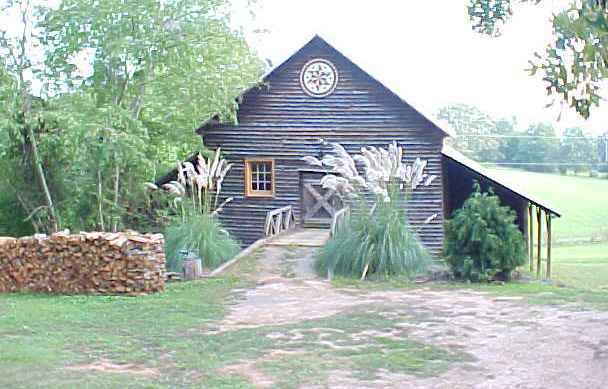
Show Us Your Shop!
by Jim Chandler
Union Mills, NC
Well I guess it all started back in 1996 when I purchased an abandoned farm complex.
The barn, circa 1899, was built into a hillside so the door you see opens into a hayloft on the second
floor. This is where I now have my workshop set up. The bridge was one of my first projects that I
worked on when I first moved in. Believe it or not there is a seven foot drop off the bridge to the
ground below. It was originally set up so you could pull a hay wagon right up to the door and
pitchfork the hay into the loft. The barn was built before the invention of the hay bailer, thus
everything was done by hand. There were several trap doors in the floor and hay could be dispensed
to the animal stalls below (five in this barn). There was also a small root cellar that was used to
store the milk until it was time to take it to market or bring it up to the farmhouse for
consumption. Along with the five animal stalls there was also a set of stanchions on the first floor
for milking cows.
The farm had
been abandoned for 30 years and it showed. The farmhouse needed a complete ground up restoration,
mudsills, windows and electrical wiring had to be replaced. Structural damage had to be repaired. The list seemed
to go on and on. After doing a few of the projects I quickly determined that I really needed to work
on the shop before the main house. Let me tell you it was a rather hard sell telling my wife that
the house took second fiddle to the shop but we had to set our priorities. So after sleeping in the
hayloft for a few nights I started making some plans for how the shop should be laid out. Lighting
was important and a spacious layout was also very important to accommodate my wheelchair.
Once the shop was completed I really started to concentrate on the farmhouse. With the completion of
the first room we went about looking for furnishings. I found that really good antiques were hard to
find and when you did come across them they were priced way out of our budget. So I went about
making what I could to furnish the home. Like everything in life we learn through experience and in
time people started to seek me out to have custom made period pieces.
The shop is 24′ x 24′ with a 6′ x 20′ tool crib just off the back. As I
continue my pursuit of mastering the skills of period furniture I find there is nothing more
important then the tools themselves. While my shop is nicely equipped with all the modern equipment
I find myself relying more and more on the hand tools that our forefathers used to make this country
what it is today. This past year I have been getting into furniture restoration work as well. There
is no better way to learn about early American furniture then through hands on experience.
You can email Jim at
James.Chandler@iwghpc.com
.